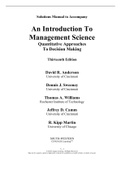Exam (elaborations)
Solutions Manual to Accompany An Introduction To Management Science Quantitative Approaches To Decision Making Thirteenth Edition David R. Anderson
- Course
- Institution
- Book
Solutions Manual to Accompany An Introduction To Management Science Quantitative Approaches To Decision Making Thirteenth Edition David R. Anderson
[Show more]



